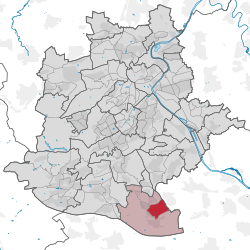Hohenheim
- For the castle this suburb is named for, see Schloss Hohenheim
Hohenheim | |
|---|---|
Suburb of Stuttgart | |
 | |
Location within Plieningen, Stuttgart | |
| Country | Germany |
| State | Baden-Württemberg |
| Admin. region | Stuttgart (region) |
| District | Stuttgart |
| City | Stuttgart |
| Borough | Plieningen |
| Founded | 1782 |
| Area | |
| • Suburb of Stuttgart | 1,563 km2 (603 sq mi) |
| Population | |
| • Metro | 575 |
| Time zone | UTC+01:00 (CET) |
| • Summer (DST) | UTC+02:00 (CEST) |
| Postal codes | 70599 |
| Dialling codes | 0711 |
Hohenheim is one of 18 outer districts of the city of Stuttgart in the borough of Plieningen that sits on the Filder in central Baden-Württemberg. The Municipality was founded in 1782.
Geography
Hohenheim sits on the Filder, a large and fertile plateau in the center of Baden-Württemberg. Hohenheim forms the Plieningen Municipality of Stuttgart along with Asemwald, Chausseefeld, Plieningen and Steckfeld.
The district was founded in 1782 when Schloss Hohenheim was constructed on the orders of Charles Eugene of Baden-Württemberg. The University of Hohenheim, as the name might imply, is based here and uses much of Schloss Hohenheim for its campus.
History
Stuttgart-Hohenheim (also known simply as Hohenheim) is a quarter of Plieningen, one of the 18 outer districts of Stuttgart, the state capital of Baden-Württemberg, Germany. Hohenheim is famous for Hohenheim Palace built in 1782 by Duke Karl Eugen of Württemberg, today the site of Stuttgart's oldest university, the University of Hohenheim.
After the duke had acquired the former manor of the Bombast von Hohenheim family, minor nobility - with Theophrastus von Hohenheim called Paracelsus as its most notable member - in 1768, he gave it to his mistress Franziska Leutrum von Ertingen, including the title of a Reichsgräfin von Hohenheim. From 1772 Karl Eugen had the manor house rebuilt as a water castle surrounded by an extended English garden featuring several midget replicas of historic buildings, an arboretum and numerous exotic plants. The construction of the present-day palace started in 1782 but discontinued with the duke's death in 1793.
In 1818 King William I of Württemberg established an agricultural school at Hohenheim, the predecessor of today's university. Today the gardens comprise the Landesarboretum Baden-Württemberg and the Botanischer Garten der Universität Hohenheim.
Attractions

Hohenheim's main attractions are Schloss Hohenheim, Hohenheim Gardens, and the Lanesarboretum. The University of Hohenheim maintains and uses these attractions for its campus. The German Agricultural Museum has a branch in Hohenheim thanks to the University, and there are zoological and veterinary museums in the castle and a museum dedicated to the history of Hohenheim.[citation needed]
Transportation
From 1888 to 1967, Hohenheim was tethered to the Möhringen-Hohenheim tracks by local railroads. Today, Hohenheim serves as the final stop of the U3 line of the Stuttgart Stadtbahn (Plieningen – Möhringen – Vaihingen).[1] The track of rail that did connect Schloss Hohenheim is decommissioned. The town (and university) is equipped with buses and streetcars that can take one to the Schloss or Degerloch.
Famous Residents
- Hermann Eckstein (1847-1893), German-South African mining magnate and banker
- Erwin Mack (1893-1942), Major General
References
- ^ "Stadtbahn-Liniennetz" (PDF) (in German). Stuttgarter Straßenbahnen AG (SSB) & VVS. September 2013. Retrieved 2013-10-05.
{{cite web}}: Unknown parameter|trans_title=ignored (|trans-title=suggested) (help)
External links



